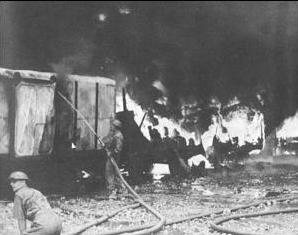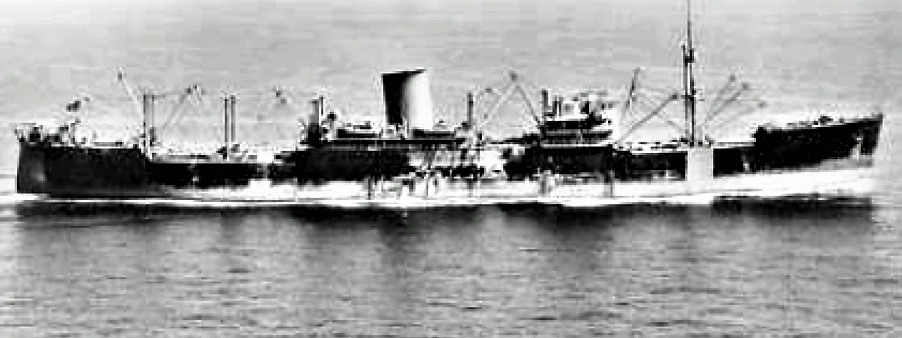WW2 Pay Services Singapore, Malaya & India

Singapore 8 February 1942
In early February 1942, the Island of Singapore was enshrouded in smoke which drifted over from the burning oil tanks at the Naval Base in the Johor Strait. During the time the Japanese had been moving down the Malay Peninsula it had been possible to send the accounts of soldiers by air to the United Kingdom, but the Royal Army Pay Corps Detachment (No 75) remained. By 10th February, with enemy action on all sides, it was decided to attempt the evacuation of personnel and the Treasury Chest, leaving a small band of volunteers behind.
The next day, while the harbour was under continuous air attack and artillery bombardment, 46 members of the Detachment embarked on the Empire Star. They had left behind 13 volunteers. All the latter were taken by the Japanese and, it is believed, perished on the fearful Siam railway. The Empire Star was part of the last convoy to leave Singapore escorted by HMS Durban. She sailed at last light on the 11th.

MV Empire Star
Next morning there was a sustained attack by Japanese aircraft. By the time the attack ceased there had been no fewer than 131 sorties against the ship. It had been hit three times, with a near miss from a bomb of major calibre. Miraculously only 23 of the 2,000 soldiers aboard were killed. Corps personnel had helped to serve the three inch guns and had joined in ineffectual rifle fire against enemy aircraft. Despite blundering into a minefield, the Empire Star docked in Djakarta. The Treasury Chest was transferred to another vessel along with four members of the Corps. It eventually found its way back to England.
Except for two officers and six soldiers who remained in Bandoeng, the rest of the party took part in an exercise to persuade the mutinous crew of SS Wu Sang to man their deserted ship. The strangest voyage in the history of the trooping of the Royal Army Pay Corps began. In addition to the soldiers there were 10 war correspondents, a white Russian lady and two dancing girls. Storms swept the vessel as she moved into the Indian Ocean. Twice the coal shifted, with dangerous listing as a result. Despite all, battered and begrimed, they disembarked in Fremantle, Australia.
In 1942, at the request of the Government of India, a major modification took place to the administration of the pay arrangements for British Troops in India, Burma and Ceylon. The Royal Army Pay Corps provided a Command Paymaster and a major Office was established in Meerut matching, in size and significance, comparable establishments anywhere in the world. While operations remained within the territorial limits of India the acquisition of currency was through normal commercial processes, with local Treasuries acting as outposts for the Reserve Bank of India. On the authority of the Staff Paymaster (l4th Army) cash was then made available to Paymasters by these Treasuries.
When the initiative was taken against the Japanese the requirement for "Spearhead" currency emerged, as in the North African and European operations. Against its possible use in Burma and Malaya BMA was printed in India. Responsibility for the production of occupation currency for the remainder of the Far East rested, however, with the United States. Consequently the printing of currency for use in Java and Sumatra, once these territories had been liberated, was done in America. It was then held by the British Staff Paymaster (Cash) on behalf of the Netherlands East Indies Military Headquarters.
The Staff Paymaster (Cash) in due course held in his Delhi Office currency of all kinds. There was a need, as in Europe, for packs which could be used by special troops operating behind the enemy lines and for this purpose newly printed currency was to be avoided. Among the more exotic currencies held were French Indo-China Piastres, Siamese Ticals, obsolete Indian Silver Rupees (valued for their high silver content) and Imperial Sovereigns. As in 1943, the forward Divisions fought their way through the jungle, currency was needed to pay guides and to purchase fresh food. Cash was therefore included in the air-drops made to re-supply the ground troops, the containers holding cash being specially identified by a green flash on the parachute.
The Field Cashiers of 14th Army worked under the most difficult conditions experienced in the War. While they became familiar with the use of air transport once on the ground they had to rely on their own feet. With no immediate protection other than the boxes in which it was carried, safeguarding specie and currency could be a nightmare. A cashier landing on Kyautaw airstrip with 300,000 rupees had to complete his round of units on foot. He was aided by his batman and three porters, who carried the boxes of rupees on their heads. The safeguard was an escort of four soldiers. The Japanese however, renowned for their ingenuity, supplied their cashiers with printing equipment. One found dead in the Kabaw Valley had dies, ink and paper with him.